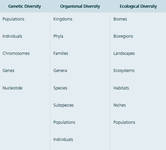Facts and Figures
Biological diversity or 'biodiversity' is described as "the variability among living organisms from all sources whether terrestrial, aquatic or marine". It includes the diversity within species (Genetic Diversity), between species (Organism Diversity) and of ecosystems (Ecological Diversity). Soil is one of the most diverse habitats on earth and contains thousands of different organisms, which interact and contribute to the global cycles that make all life possible.
A few figures on soil biodiversity
Nowhere in nature are species so densely packed as in soil communities. Soil biodiversity is characterized by:
- Over 1000 species of invertebrates may be found in a single m2 of forest soils.
- Many of the world’s terrestrial insect species are soil dwellers for at least some stage of their life-cycle.
- A single gram of soil may contain millions of individuals and several thousand species of bacteria.
- A typical, healthy soil might contain several species of vertebrate animals, several species of earthworms, 20-30 species of mites, 50-100 species of insects, tens of species of nematodes, hundreds of species of fungi and perhaps thousands of species of bacteria and actinomycetes.
- Soil contains the organism with the largest area. A single colony of the honey fungus, Armillaria ostoyae, covers about 9 km2.

